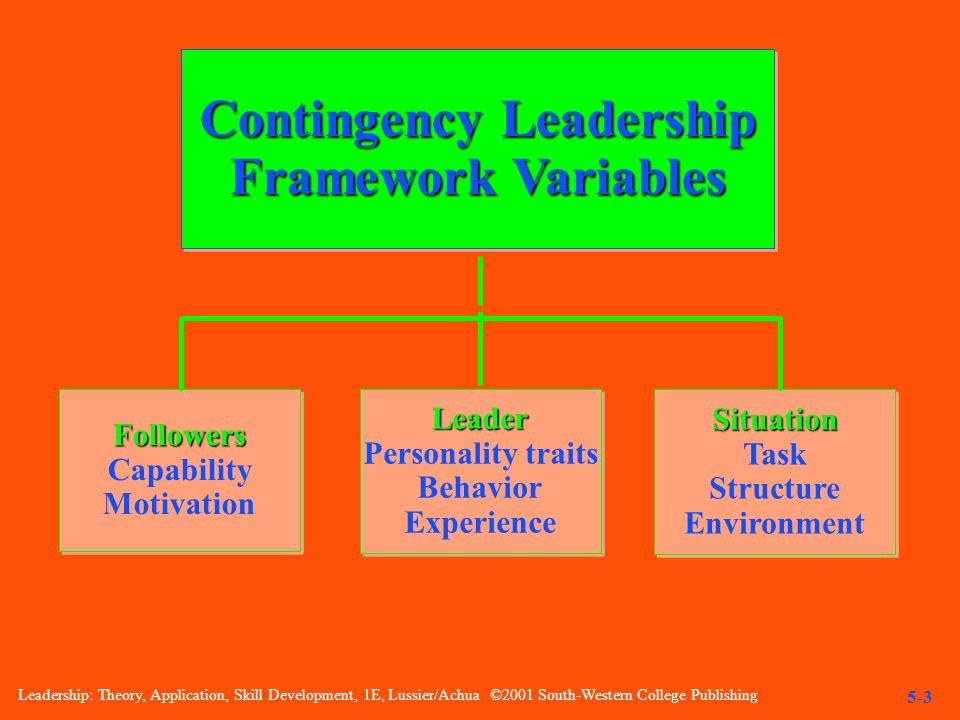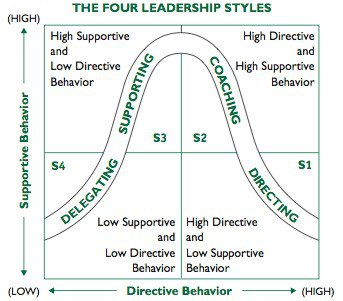The situation leadership theory and model
theories.
• Identify & describe major variables in contingency
• Contingency means “it depends” – one thing depends on other things.
• For a leader to be effective there must be an appropriate fit between the leader’s behavior & style & the followers & the situation.
• Leaders should not change styles; they should change the context of their job.
Contingency Leadership Theory and Model
Contingency Leadership Theory and Model
• Leader of a designated orientation can be helped to change situation or to adjust better.
2. Situational favorableness.
3. Determining appropriate leadership style for situation.
Contingency Leadership Theory and Model
2. Situational favorableness:
• Refers to degree to which a situation enables the leader to exert influence over the followers.3. Determining appropriate leadership style for situation:• If leadership style matches, user does nothing since they are successful in that situation.
• If leadership style does not match situation, leader may be ineffective & will need to change to a job that
matches style.
|
|
|
|
| Helps explain why a hard working manager | |
|
|
| in another. |
|---|
• Thus, there are four contingency theories whose objective is to choose the leadership style that matches the situation to maximize performance
Major Types of Contingency Leadership Theories and Models There are four major types of contingency leadership theories and models:
| I. |
|---|
Major Variables in Contingency Leadership Theories
• The framework for contingency leadership variables
Major Variables in Contingency Leadership Theories
leadership.
•Model focuses on who makes decisions – a
leader’s choice of a leadership pattern should be2. Subordinates – followers’ preferred style for leader based on personality & behavior.
3. Situation/Time – environmental considerations (org size, structure, goals, technology) in
selecting a leadership style. Participative style is time consuming; autocratic style works in
situations with strict time deadlines.
– Leader clearly state style (follower’s authority) being used.
– Leader not try to trick followers into thinking they made a decision that was actually made by leader.
• Criticism – determining which style to use, & when, is not clear in model.
II. Situational Leadership Theory and Model
• Basic premise – different situations demand different kinds of leadership. To be an effective leader requires that one adapt his/her style to demands of different situations.
• Stresses that leadership is composed of both a directive & a supportive dimension; each has to be applied appropriately in a given situation.
a) Direction (task behavior) a leader give.
b) Socio-emotional support (relationship behavior) a leader gives.
Situational Leadership Theory and Model
| commitment to form a distinct level of |
|---|
| unclear – combination of confidence & |
|---|
|
|
III. Normative Leadership Theory and Model
Normative Leadership Theory and Model
•Is called normative because it provides a
sequential set of questions that are rules
(norms) to follow to determine best leadership style for given situation.
2. Consult individually – leader gets info, suggestions.
3. Consult group – leader holds group meeting & gets input from followers.
2. Importance of commitment. 3. Leader expertise.
4. Likelihood of commitment. 5. Group support for objectives. 6. Group expertise.
• Characteristic of decision are:
– Focus – effective decisions with minimum cost.– Value – value placed on time.
|
||
|---|---|---|
Normative Leadership Theory and Model
|
|---|
Path-Goal Leadership Theory and Model
•In contrast to situational approach (a leader must adapt to dev. level of subordinates) & unlike contingency theory (emphasizes match between leader’s style & specific situational variables), path-goal emphasizes relationship between leader’s style & characteristics of subordinates & the work setting.
Model
•Is based on motivation theories of goal setting & expectancy theory, which state that
Path-Goal Leadership Theory and
Model
–Increasing the rewards that follower values & desires.
Path-Goal Leadership Model Variables
2. Supportive – similar to consideration behavior (Ohio State).
3. Participative – shared decision-making.
2. Locus of control – employees believe they control goal achievement (internal), or goal achievement is controlled by others (external).
3. Ability – employees’ ability to perform tasks to achieve goals.
|
|
||
|---|---|---|---|
|
|
||
|
|
||
|
|


